Cooking & Cocktail Series THE PERFECT PASTA

WITH PATRICK SCULLY, YOUR NATIONAL DIRECTOR OF FOOD, BEVERAGE & CULINARY EXPERIENCE




WITH PATRICK SCULLY, YOUR NATIONAL DIRECTOR OF FOOD, BEVERAGE & CULINARY EXPERIENCE


The history of pasta is more complex than it may seem. The word itself translates to paste in Italian, referencing the dough made from a combination of flour and water or eggs, or both.
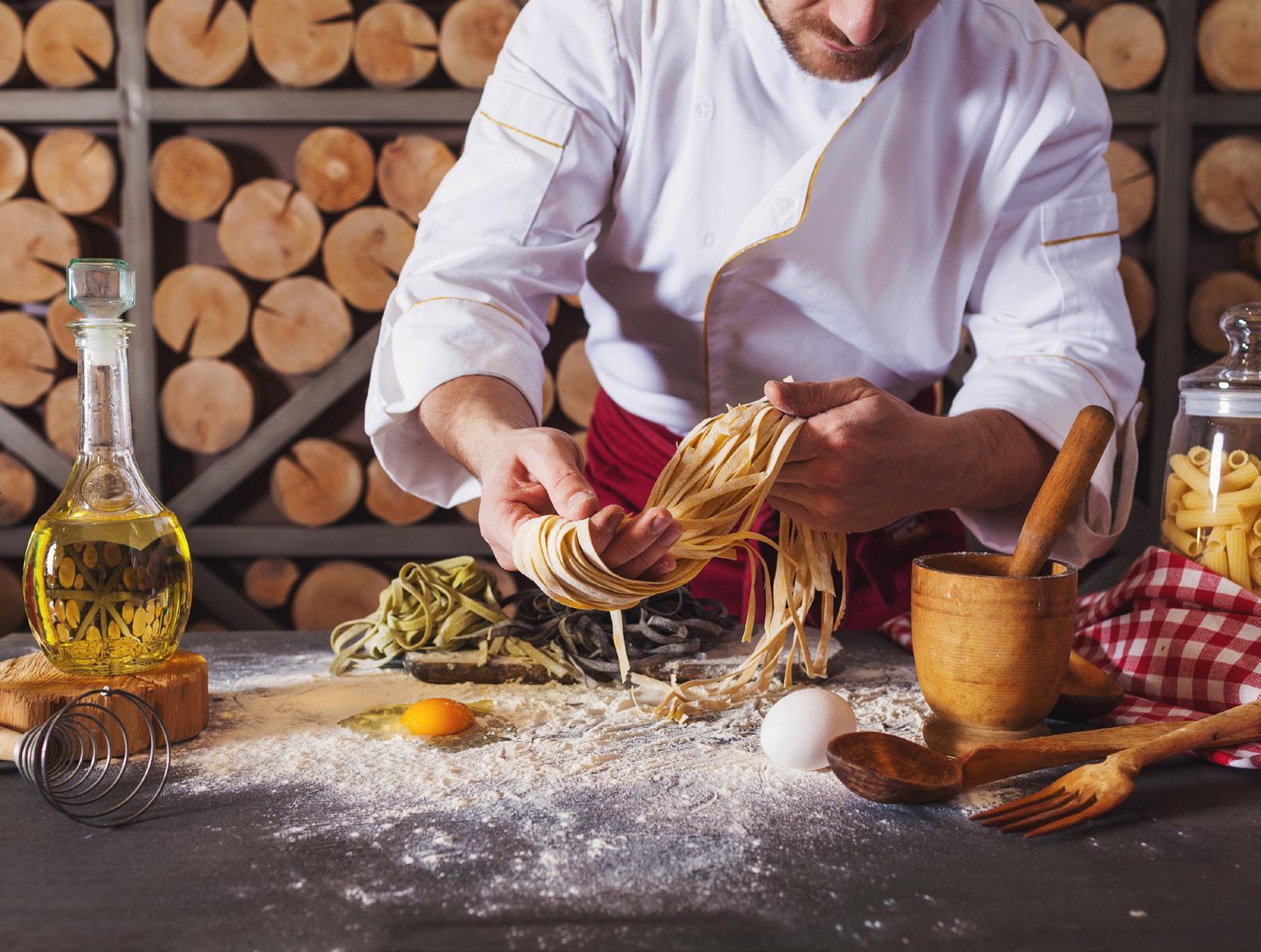
In the early 2000s, a 4000-year-old bowl of noodles was found at an archaeological site in northern China, aiding the belief that noodles were created in China.
Traveling from Asia, noodles arrived in Europe. Some believe that nomadic Arabs are responsible for bringing early forms of pasta westward.
In the 1st century AD, lagana were fine sheets of fried dough. Writings in the 2nd century found an early recipe for lagana, citing sheets of dough made of wheat flour and the juice of crushed lettuce, then flavored with spices and deep-fried in oil.
In a 5th-century cookbook, a recipe showing the evolution of lagana describes the dish as layers of dough with meat stuffing, believed to be an ancestor of modern-day lasagna.
After pasta reached the Mediterranean, the process
was refined. Durum wheat became the ideal ingredient of pasta flour because of its high gluten, low moisture, and long shelf life.
While we think of pasta as a culturally Italian food, it is likely the descendant of ancient Asian noodles. It became firmly rooted in Italian culture because of pasta affordability, shelf life, and versatility.
The warm Mediterranean climate of Italy is suited to growing fresh vegetables and herbs, allowing Italians to create a delicious variety of pasta sauces.
Tomato-based sauces emerged as a favorite complement to pasta, and tomatoes remain the most
popular ingredient in pasta sauce today.
A noodle is most commonly known as an Asian food made from multiple types of flour, salt, and water. If eggs are added to the recipe, it becomes egg noodles.
Pasta is an Italian food made from durum semolina flour or all-purpose flour, salt, water, and eggs. The dried version usually contains no eggs, but the fresh version does.
Fresh pasta is traditionally served with delicate sauces. In contrast, dried pasta works better with ragu sauces, soups, and casseroles due to its firm structure.
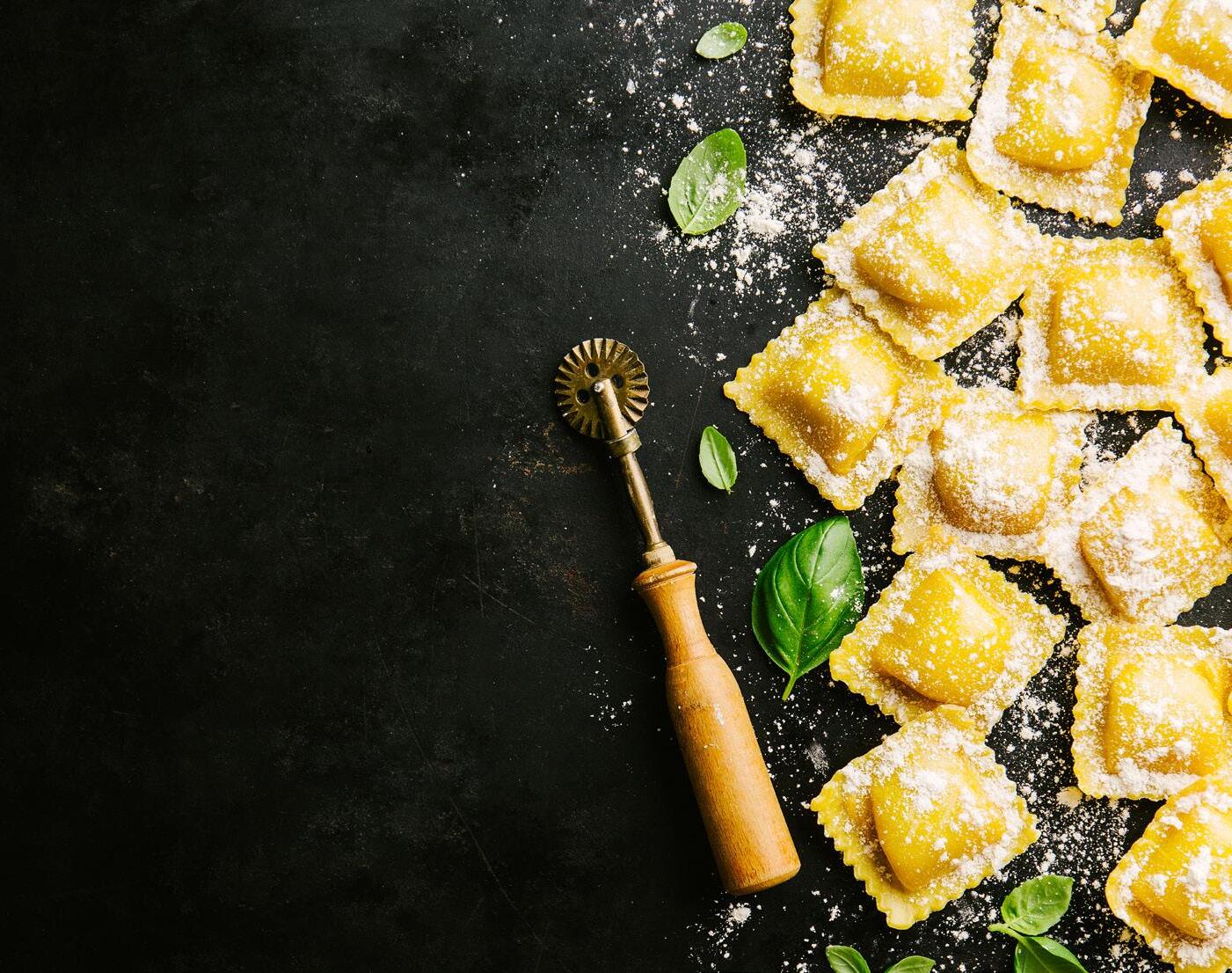
» Bucatini
» Cannelloni
» Capellini
» Cavatappi
» Ditalini
» Elbows
» Farfalle
» Fusilli
» Gemelli
» Orzo
» Pappardelle
» Ravioli
Click to read about 44 types of pasta and how to use them.
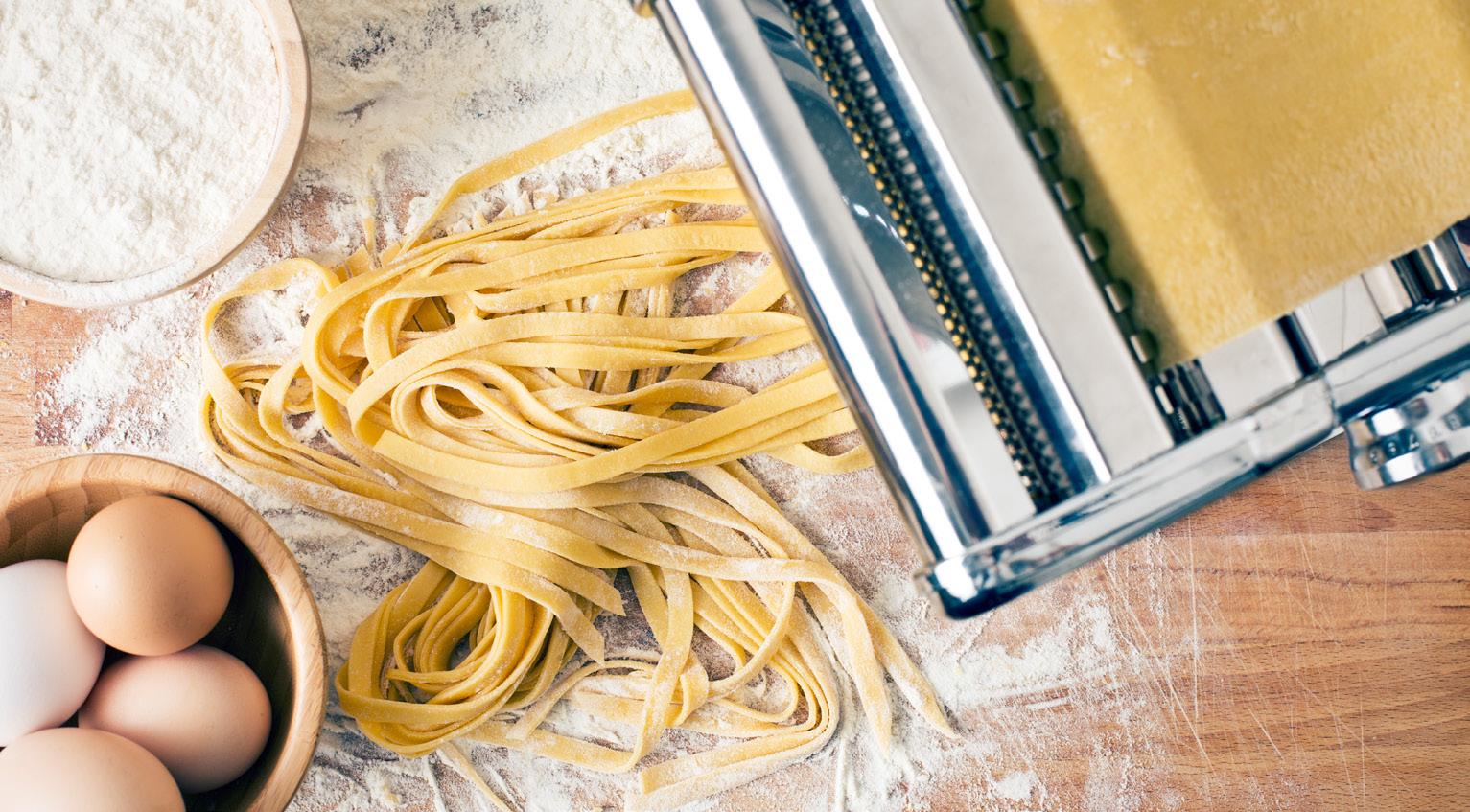
Total Prep & Cook Time: 85 Minutes
Total Servings: 4-6
» 9 ounces (about 2 cups) of all-purpose flour, plus more for dusting
» 2 whole large eggs (about 4 ounces)
» 4 yolks from 4 large eggs (about 2.5 ounces)
» 1 teaspoon kosher salt, plus more for salting water
1. To Make the Dough: Pour flour into a mound on a large, clean work surface. Make a well in the center about 4 inches wide. Pour whole eggs, egg yolks, and salt into the well and, using a fork, beat thoroughly. When combined, gradually incorporate the flour into the eggs until a wet, sticky dough has formed.
2. Using a bench knife, scrape excess dough from fork and fingers. Begin to fold additional flour into the dough with the bench knife, turning the dough roughly 45 degrees each time until the dough feels firm and dry and can form a craggy-looking ball (2 to 5 minutes).
3. Press the heel of your hand into the ball of dough, pushing forward and down. Rotate the ball 45 degrees and repeat. Continue until the dough develops a smooth, elastic texture similar to a firm ball of Play-Doh. If the dough feels too wet, add flour in 1 teaspoon increments. If the dough feels too dry, add water slowly using a spray bottle.
4. Wrap the ball of dough tightly in plastic wrap and
allow it to rest on the countertop for 30 minutes.
5. To Roll the Pasta: Place a sheet of parchment paper on a tray or cutting board and lightly dust with flour. Unwrap the rested dough and cut into quarters. Set one quarter on a work surface and re-wrap the remaining dough. With a rolling pin, flatten the quarter of the dough into an oblong shape about ½-inch thick.
6. Set the pasta maker to the widest setting and pass the dough 3 times through the machine.
7. Place dough on a lightly floured work surface. Fold both ends in, meeting at the center of the dough, and then fold the dough in half where the end points meet, trying not to incorporate too much air into the folds. Using a rolling pin, flatten the dough to ½-inch thick. Pass through the rollers 3 additional times.
8. Narrow the setting by 1 notch and repeat Step 7. Repeat once more (the dough should now have passed through the third widest setting). Continue passing the dough through the rollers, reducing the thickness by 1 setting each time until it reaches the desired thickness. It should now be delicate, elastic, and slightly translucent.
9. Place rolled dough onto a work surface or baking sheet lightly dusted with flour or lined with parchment paper, folding the dough as necessary
so it fits; sprinkle with flour or line with parchment between folds to prevent sticking.
10. Cover the dough with plastic wrap or a kitchen towel to prevent drying, then repeat Steps 5 through 9 with the remaining dough quarters. If making noodles, cut the dough into 12- to 14-inch segments.
11. To Cut Noodles: Adjust the pasta machine to the noodle setting of your choice. Working one dough segment at a time, feed dough through the pasta cutter. Alternatively, cut the folded dough by hand with a chef’s knife to desired width.
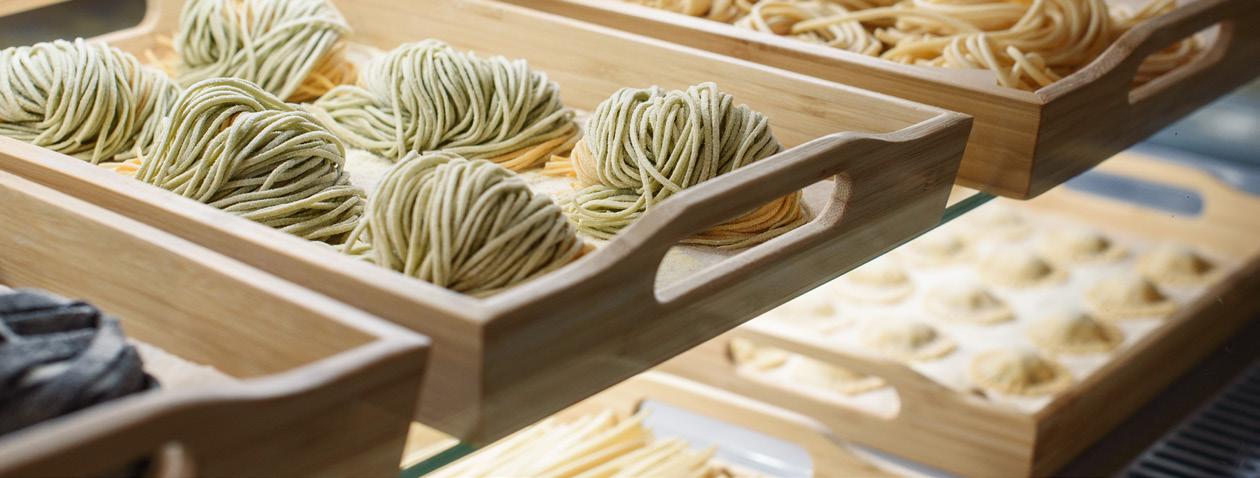
12. Divide the cut noodles into individual portions, lightly dust with flour, and curl into a nest. Place on a parchment-lined rimmed baking sheet and gently cover with a kitchen towel until ready to cook. Pasta can be frozen directly on the baking sheet, transferred to a zipper-lock freezer bag, and stored in the freezer for up to three weeks before cooking. Cook frozen pasta directly from the freezer.
13. To Cook: Bring a large pot of salted water to a rolling boil. Add pasta, stir gently with a wooden spoon, chopsticks, or a cooking fork, and cook, tasting at regular intervals, until noodles are just set with a definite bite, about 1 ½ to 2 minutes. Drain, toss with sauce, and serve.
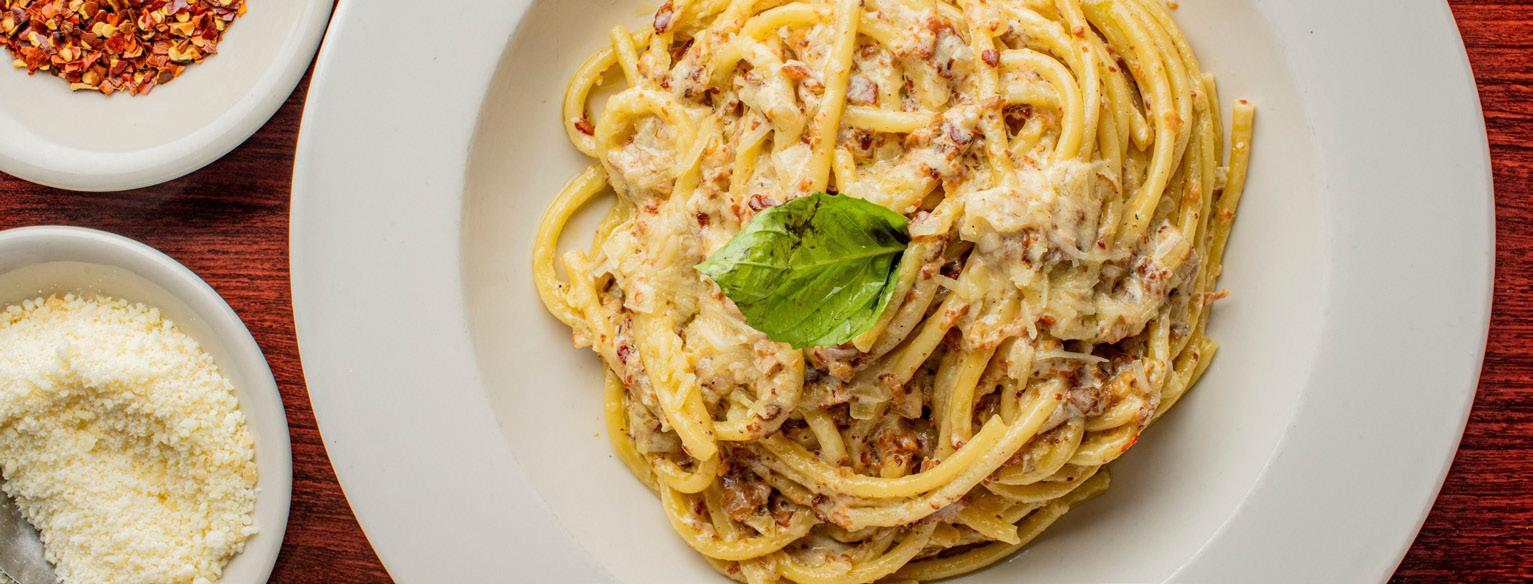
Pasta alla carbonara and spaghetti alla carbonara were unrecorded before WWII; notably, it is absent from Ada Boni’s 1930 La Cucina Romana (“Roman cuisine”). Carbonara was first mentioned in print in 1950 in the Italian newspaper La Stampa. American military officers sought after the dish, believing it was Roman since many Italians were eating eggs and bacon supplied by troops from the United States.
Food historian Luca Cesari states that Carbonara was born in Rome around 1944, just after the city’s liberation, likely because of the bacon that flowed in quantity with the American army. The recipe was likely brought to the United States by an American serviceman who had passed through Rome during the Italian Campaign or by an Italian American who had met it in Rome. According to Cesari, this makes Carbonara a dish that closely links Italy and the United States.
» 12 ounces tonnarelli, spaghetti, mezze maniche or rigatoni
» 4 ounces guanciale or rindless bacon
» ¼ cup grated Pecorino Romano (or Parmigiano Reggiano)
» 4 fresh large egg yolks
» Salt & black pepper
1. Cut guanciale into ¼″ layers, then into 2″ strips.
2. Combine the egg yolks with the grated cheese and a pinch of black pepper.
3. Brown the strips of guanciale for 2 minutes in a pan, until crisp, then turn off the heat and leave to cool.
4. Bring a large pot of water to a boil. Add salt. Cook the pasta, setting aside a ladleful of the pasta cooking water, until al dente. Drain.
5. Pour the reserved hot water into the frying pan with the cooled guanciale, then transfer the pasta to the same pan and mix together. Add the yolk and cheese mixture, stirring rapidly.
6. In the warm pan with the hot pasta, the eggs will cook gently and become creamy – don’t stir over heat otherwise the carbonara will become lumpy. It’s important to stir quickly to prevent the yolks from congealing and taking on the texture of scrambled eggs.
7. Season with freshly milled black pepper and serve immediately on heated plates.
Modern fettuccine Alfredo was invented by Alfredo Di Lelio in Rome. In 1892, Alfredo Di Lelio began working in a restaurant in Piazza Rosa run by his mother, Angelina. Di Lelio invented fettuccine al triplo burro (later named “fettuccine all’Alfredo” or “fettuccine Alfredo”) in 1907 as a treat for his wife Ines, by adding extra butter or triplo burro to the fettuccine.
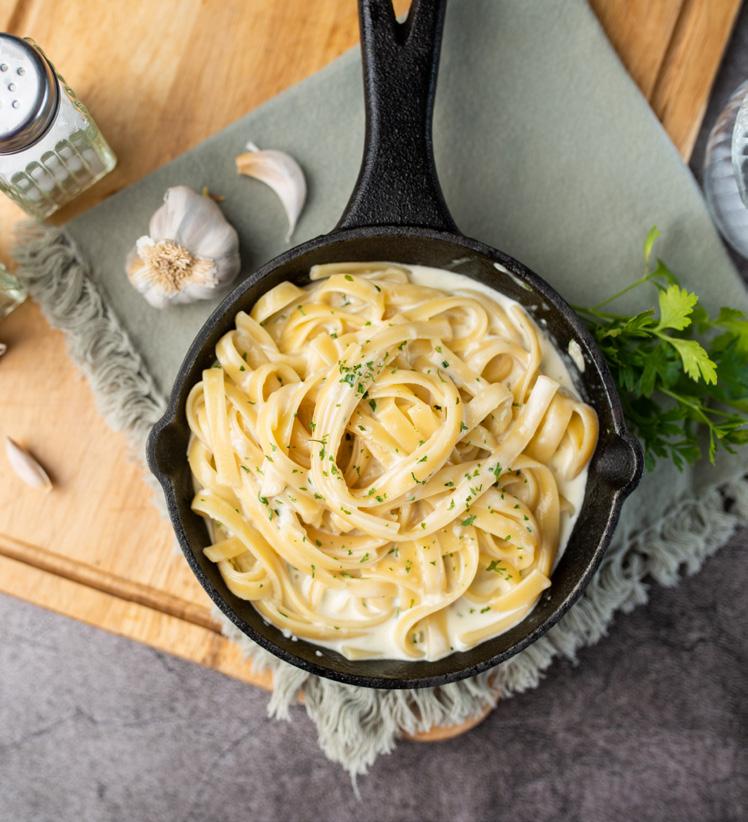
Di Lelio later opened his own restaurant, then called “Alfredo,” in 1914 in central Rome. In 1943, during the war, Di Lelio sold the restaurant to two of his waiters. In 1950, Alfredo Di Lelio and his son opened a new restaurant in Piazza Augusto Imperatore, Alfredo all’Augusteo, now managed by his niece Ines. The two restaurants competed vigorously with escalating puffery, each claiming respective titles such as: “the king of fettuccine,” “the real king of fettuccine,” “the magician of fettuccine,” “the emperor of fettuccine,” and “the real Alfredo.”
» 8 tablespoons unsalted butter, cubed
» ¾ cup freshly grated parmesan cheese + ¼ cup for garnish
» ½ cup of hot pasta water
» 1 pound dried fettuccine or
» 1 ½ pounds fresh fettuccine pasta
» Sea salt and pepper to taste
1. Start by adding the cubed unsalted butter to a large bowl or frying pan. Next, sprinkle half of the parmesan cheese over top of the butter.
2. Drop the fettuccine pasta in a large pot of boiling salted water. If you are using dry pasta this will take 7 to 8 minutes for it to reach al dente. When using fresh pasta, it will only take 90 seconds to two minutes for it to reach al dente.
3. Drain the pasta and add it to the bowl with the butter and parmesan cheese. Add about ½ cup of hot pasta water to the bowl as well.
4. Begin tossing the pasta by slightly dipping the bowl down, sharply pushing it forward, then immediately bring it back. This will take some practice.
5. While tossing, being to sprinkle in the remaining parmesan cheese.
6. Season with salt and pepper.
7. Serve with additional parmesan cheese. Add optional garnish of chopped fresh flat-leaf Italian parsley.
» 44 Types of Pasta And When You Should Be Using Them: www.tastingtable.com/764058/ types-of-pasta-and-when-you-should-be-usingthem
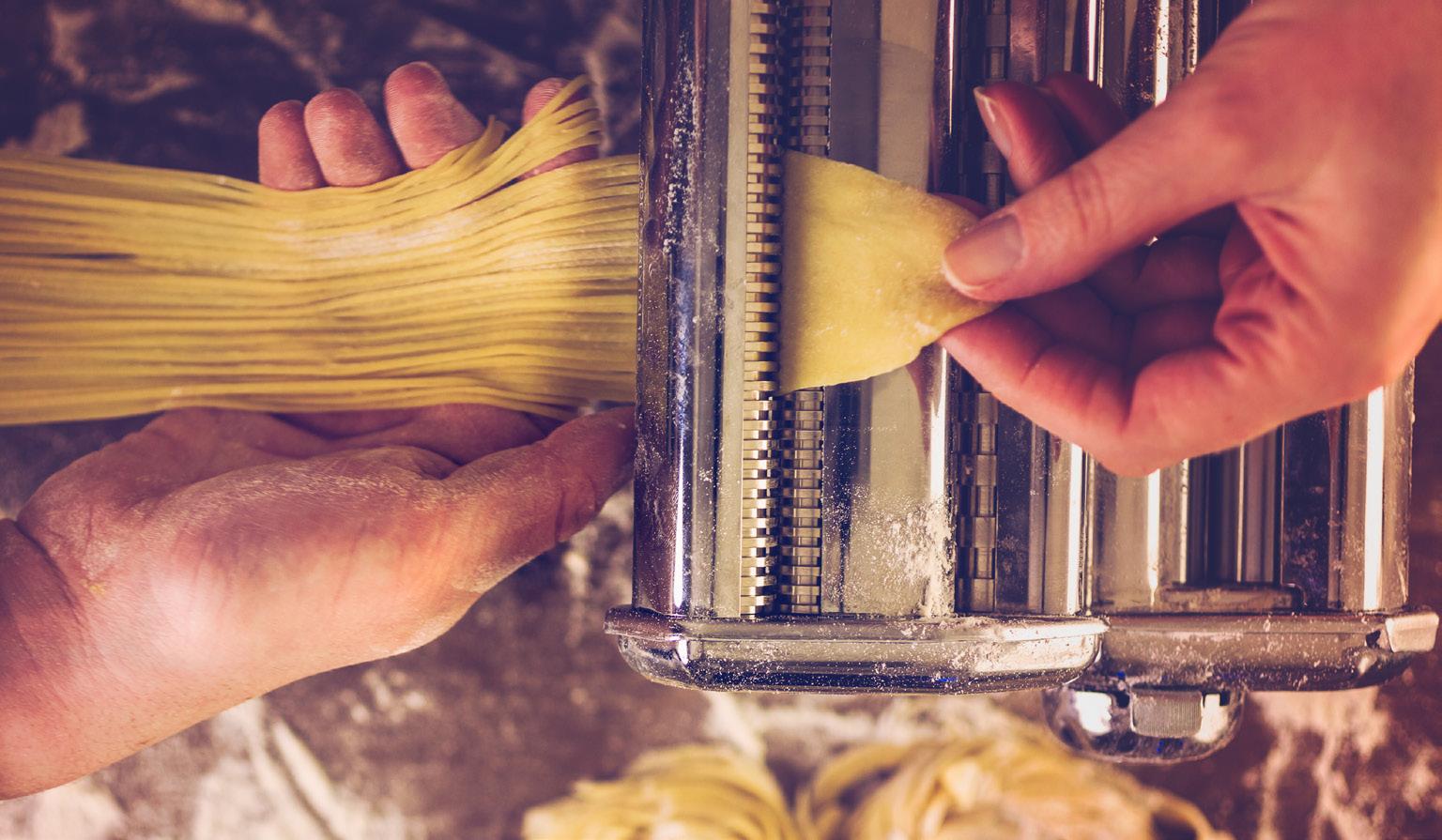
» Homemade Fresh Pasta - Serious Eats: www.seriouseats.com/fresh-egg-pasta
» Classic Carbonara - La Cucina Italiana: www.lacucinaitaliana.com/italian-food/how-tocook/how-to-make-original-carbonara
» Authentic Alfredo Sauce - Chef Billy Parisi: www.billyparisi.com/alfredo-sauce-recipe
» For the Carbonara:
Saula Frascati Black Label | Total Wine & More
» For the Alfredo:
Ponzi Chardonnay Reserve | Total Wine & More
» Mixer (some Manual and some Technology)
• KitchenAid® Artisan Stand Mixer, 5-Qt.Williams Sonoma (williams-sonoma.com)
• KitchenAid® 3-Piece Pasta Roller & Cutter Attachment Set - Williams Sonoma (williams-sonoma.com)
» Easiest with Technology
• Philips Artisan Smart Pasta & Noodle Maker - Williams Sonoma (williams-sonoma.com)
» Manual Labor
• Imperia Pasta Maker Machine - Heavy Duty Steel Construction with Easy Lock Dial and Wood Grip Handle - Model 150 Made in Italy - Amazon.com
» OXO Good Grips Stainless Steel Scraper & Chopper, Silver/Black - Amazon.com
» J.K. Adams FRP-1 Maple French Rolling PinAmazon.com
» Cuisipro 4 Sided Box Grater, Regular, Stainless Steel - Amazon.com
» Qimh Collapsible Colander Set of 3 Round Silicone Kitchen Strainer Set - 2 pieces 4 Quart and 1 piece 2 Quart (green,blue and purple)Amazon.com
» OXO Good Grips 12-Inch Stainless-Steel Locking Tongs - Amazon.com